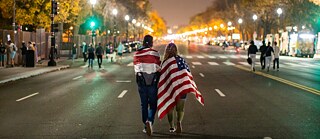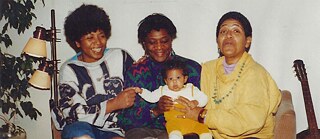Projektionsflächen
The Flag
Sowohl in den USA als auch in Deutschland können Fahnen kontrovers wirken – teils wecken sie Stolz, teils Unwohlsein. Jocelyn Robinson redet mit Flaggenkenner*innen über Geschichte und mögliche Dimensionen dieser Symbole.
Diese Folge anhören: Apple Music | Spotify | Download
Diese Folge stammt von Jocelyn Robinson. Sie ist Pädagogin und freie Journalistin in Yellow Springs, Ohio und engagiert sich stark für den Erhalt des Radios. 2019 war sie mit dem Programm „Radiobrücke Reversed“ des Goethe‑Instituts zu Gast in der Redaktion des Deutschlandfunks Kultur in Berlin. Mehr über Jocelyns Arbeit findet Ihr auf ihrer Website. Diese Episode deckt die Symbolik und den Patriotismus auf, der hinter den Nationalflaggen der USA und Deutschland steckt. Auch U.S. Veteranen und Militärhistoriker kommen dabei zu Wort. John C. Sims hat uns freundlicherweise erlaubt, seinen Afro‑Dixie‑Remix „Dixie“ in der Folge zu verwenden. Außerdem werden „Stars & Stripes Forever“ der U.S. Navy Band und „The Star-Spangled Banner“ von Nathan Hardman gespielt. Beide Lieder gehören zur public domain. Yassine El Mansouri hat das Foto zur Folge aufgenommen. Außer der Folge „The Flag“, die auch auf Deutsch vorliegt, hat Jocelyn Robinson zu THE BIG PONDER die Folge „Home“ beigesteuert und zu THE BIG POND die Folgen „A Singer’s Life“ und „Showing Our Colors“. Tom Amrhein und Juliet Fromholt haben bei der Redaktion dieser Folge unterstützt.
Transkript
[CAR SOUNDS]
Jocelyn Robinson: Here we are in beautiful downtown Zanesville, Ohio, trying to find our way to American Pride.
Siri: Starting route to American Pride Power Equipment. Head east on Market Street, then turn right onto North 4th Street. At the light, turn right onto Main Street.
[CAR SOUNDS]
Jocelyn Robinson: Ah, there it is!
Siri: Turn left, then the destination is on your right.
Jocelyn Robinson: It is a huge American flag flying from a tall pole, tall enough to be visible from Interstate 70, the highway that cuts East-West through Ohio and the American heartland. It’s a grim winter day, threatening snow, but the Red, White & Blue stars and stripes ripple boldly across the gray clouds.
Let me go take a look at this big-ass flag.
American Pride sells riding mowers and chainsaws, snow blowers and power washers, all the equipment needed to tame the wild suburban landscape. Old Glory flies high over the lot, over neat lines of shiny bright green grass-cutters. I went into the showroom, masked up, of course, to find someone who could tell me more about the ginormous flag.
Sarah Haren: This flag comes from Texas, it is 30 by 60 feet. We special order it about four different times a year to make sure that when it starts to tatter, we replace it.
Jocelyn Robinson: Sarah Haren runs the office at American Pride. I asked her why the owner planted such a large flag outside his business.
Sarah Haren: I know he’s just very patriotic, obviously he named his business American Pride. The flag has been a symbol of his business for the past 25 years, I believe that he’s had this business. And it’s just very important to him, so when he built the new store, he wanted to make a big statement and show his support to veterans and a thank you for all their service, their sacrifice, everything they’ve done, so. It’s beautiful. I love it. You know friends, family that don’t live in this area and you mention Zanesville and try to say where it’s from, ‘Oh if you go down the Interstate, you know the big flag?’ Yeah. That’s Zanesville. [LAUGHS] That’s where I work, actually. I think it’s beautiful, I think it’s a great statement, and I’m proud to work here.
Jocelyn Robinson: Oh, do you know if that’s the biggest flag in Ohio?
Sarah Haren: I believe we do have the largest flag in Ohio, and I will verify that for you ... it is like I said 30x60, it’s on a 120-foot pole, and it is the largest flag in the State of Ohio.
Jocelyn Robinson: Ok, great. Thank you so very much!
Sarah Haren: You’re very welcome.
Jocelyn Robinson: [TALKING TO ANOTHER CUSTOMER] It’s the biggest flag in Ohio!
Male Voice: Is it really?
Jocelyn Robinson: Hmhm!
Jocelyn Robinson: Well, with some further research I found out that there are actually a handful of flags this size in Ohio, visible at businesses right off the interstate like this one. But there are bigger flags in the United States, like one that’s twice this size in Sheboygan, Wisconsin that flies atop a 400-foot pole. And out in Utah there’s ‘Big Betsy’, touted as the largest free-flying flag in America. Even bigger is the Superflag. 225x500 feet, it weighs in at 3,000 pounds and takes hundreds of people to unfurl it at events like the Superbowl, securing it a spot in the Guinness Book of World Records.
[MUSIC BRIDGE — STARS & STRIPES FOREVER]
Jocelyn Robinson: Flying the Stars and Stripes does make a statement. These big flags represent big pride, big American pride. But that’s not all they symbolize. Now, I’m no vexillologist — that’s someone who studies flags — but I’m fascinated by these pieces of cloth and how they are used to create and maintain identity, how they represent complex histories and political ideologies. With a recent presidential election, there’s been a lot of flag-waving in the U.S. of late, and I’ve become intrigued about what it all means, and what these flags symbolize.
[PLEDGE OF ALLEGIANCE]
School Children: I pledge allegiance to the flag of the United States of America and to the republic for which it stands, one nation, under God, indivisible, with liberty and justice for all...
Jocelyn Robinson: In the U.S., we’re taught as children to see the national flag as the embodiment of our country and its founding ideals. In fact, the Code of Laws of the United States of America Title 4 section 8 (j) states – and I quote – “the flag represents a living country and is itself considered a living thing.”
Dave Manges: The flag is the symbol of the nation, that we should all be paying respect and tribute to. It represents us just like we represent it.
Jocelyn Robinson: Dave Manges is 30-year veteran of the US Army.
Dave Manges: Once you’ve fought under it, once you’ve seen a buddy buried under it, once you’ve ... it takes on a whole new life of its own after that.
Jocelyn Robinson: We spoke at the National Cemetery in Dayton, Ohio on a cold, clear day. Bright sunlight reflected off the rows and rows of white marble headstones that march across this silent hillside west of downtown. Soldiers who fought in every major conflict back to the Revolutionary War are interred here. Over 55,000 of them.
In retirement, Dave’s served as a member of the cemetery’s Honor Squad. It provides military honors for veterans buried here — the three-volley rifle salute, a bugler playing “Taps,” and the ceremonious folding and presentation to the bereaved of the flag that drapes the casket. Flags have great importance on these hallowed grounds, and that flag code is taken seriously in terms of what to do and what NOT to do.
Dave Manges: Basic flag etiquette is respecting and taking care of the flag, and it’s how you carry it, how you fold it, how you salute it, how you display it. It pretty well articulates everything. I would probably say the two most violations are the wearing the clothing, especially when I cringe at a US-flag bikini, just ... and the second one is the flag should never be held horizontally, it should be flying free, and I just can’t believe the NFL has a horizontal flag at their games, held by a service member, which is a total violation of the flag code, yeah.
Jocelyn Robinson: Well, so much for the patriotism of the Superflag. But I want to know more about this symbol, its history and how it came to shape our sense of a national identity.
Dr. Jonathan Winkler: Alright, I’m Jonathan Winkler, I’m the Chair of the Department of History at Wright State University here in Dayton, Ohio. I guess I’m happy to provide some of the historical background for some of these things.
Jocelyn Robinson: Winkler is a historian of U.S.-foreign relations and military history. Flags are more than living symbols, they’re functional, too.
Dr. Jonathan Winkler: Flags have been, for the country, deeply significant. On a battlefield, the purpose of the flag, in the 19th century and earlier, and before you get to changes in warfare that distributed soldiers across the battlefield, the purpose of the flag was to identify where your team was. I use the word team kind of loosely, but the people that were on your side and not the other side. And as you had the literal fog of war, as gunpowder has turned into gun smoke that is then filling up that battle space, it’s difficult to see, but as long as you could observe the flag that was within 50 yards of you, that showed where you were or where your neighboring units were, you had an idea that you were not alone, that you were with a group that still stood.
And so, one of the most significant positions of honor in any combat unit, still today, but certainly absolutely in the 19th century, and certainly absolutely in the Civil War, was the position of the Color Sergeant, the person who had the responsibility of keeping that flag waving, to show that there was forward movement or to hold to it, that they had stayed in one position, they were holding a line. And the Civil War is replete with stories of Color Sergeants being shot down, the men who were the standard bearers being shot down, units that went through six or seven standard bearers in a particular battle. Do you know who the first African-American medal of honor recipient was?
Jocelyn Robinson: That would be Sergeant William H. Carney, at the Battle of Fort Wagner in 1863. I might note that he wasn’t actually awarded the medal until 1900, about 37 years after the fact. But better late than never, I suppose.
Jonathan Winkler: It was in fact, a member of the 54th Massachusetts, who as the colors moved with the unit in the attack, the colors are shot down and he ran over and picked them up. And even though he was himself shot, he stood with the colors and did not let them fall. Why that matters is, if you’re on the other side, there’s all this sort of opposition in front of you, but you know where they are, because you can see that flag. So, all you have to do is shoot at the flag, and you’re likely to hit some of them, which means that it’s a particularly dangerous position. And yet men chose to take that position on that, that position of honor.
We can’t really envision such a thing, particularly because battlefields are so distributed these days. But to appreciate just how much those men were bonded with one another and around that symbol, that symbol stood not only for the country that they were a part of, the state from which they came, the unit of which they were a part, but really it was a stand-in for all of the people, the men with whom they had chosen to go off to do this most dangerous task. And so, in a way, people wanting to fly flags later are trying to tap into that indirectly without fully appreciating it. But it also helps us to understand, or at least try to appreciate a little, just how much the flag means something more. It’s not that it means the country. It really means the standing together with the others who are of the same group.
Jocelyn Robinson: Okay. I get it. The U.S. flag is a symbol of patriotism, of liberty and justice for all, under which Americans have fought and died and bonded. And it was during a particular war that this symbolism solidified, the Civil War. Today, it is often flown in the company of other flags. One in particular that I find perplexing, given that history.
[SOUND FROM CHARLOTTESVILLE]
Jocelyn Robinson: In the summer of 2017, a demonstration in Charlottesville, Virginia was organized to protest the planned removal of a Confederate monument, a statue of General Robert E. Lee, from a public park there. Video from the Unite the Right rally shows members of far-right groups — Proud Boys, Boogaloo Bois, Neo-Nazis, Three Percenters, Oath Keepers, and more — marching through the streets, chanting racist and antisemitic slogans, visibly brandishing signs and symbols of white supremacy. And some carried the US flag. Many carried another flag, though, one with thirteen white stars held in a blue diagonal cross on a field of red. This flag was never really the symbol of all the states that seceded from the Union in 1860 and 61; it was actually the Battle Flag of the Army of Tennessee. It was resurrected almost a century after the War Between the States for a very specific purpose. Here’s Jonathan Winkler.
Jonathan Winkler: Certainly, the Confederate Battle Flag is something that we’ve seen a lot of, it’s something that, its role has waxed and waned. It had largely been, insofar as I understand, been set aside in the United States until the 1950s and 1960s, when it becomes adopted by both the groups in the South that were opposed to desegregation, it becomes a symbol around which they can rally themselves. And then by the time that you get to the Centenary of the U.S. Civil War, then the symbol is brought forth in the way that all of the symbols of that period are brought forth as a way of people saying, okay, well, so what were the symbols that were there and what do we need to know about them in terms of general historical interest?
❡
Alma Coleman: I can’t wrap my head around how you can be a patriotic citizen of the United States of America and fly the flag of the country’s traitors, at one point in time, people who’ve wanted to destroy the country.
Jocelyn Robinson: Alma Coleman is also an Army veteran, who comes from a family of veterans. As a woman of color, when she sees a Confederate flag, she knows exactly what she needs to know about what that symbol means.
Alma Coleman: I tie it to racism, people who are deeply ingrained in a racist ideology in this country, are ... they say it’s not, but it is, it’s connected. And that flag is one of those things that tie them to that ideology. I’m not a scholar of the flag. I just know the feeling it raises in me when I see it. It raises fear for me. When I see someone waving a Confederate flag, I go the other direction. I do not see that person as a possible ally of any sort. Um, I’m not saying they will come after me with a hatchet or something, but I don’t view them as someone that I would view as being friendly to someone like me, any person of color, any person that is different from a cisgender white American.
Jocelyn Robinson: And there were other flags in Charlottesville, too, including one you might see here in the U.S., but not in its country of origin. Nils Zurawski is a professor at the University of Hamburg. I spoke with him to get a German take on Nazi flags flying openly, the way they did in Charlottesville.
Nils Zurawski: We see American Nazis walking, you know, with the, with the well-known regalia that we have from our past and the American flag. And that is very confusing to watch, because the American, the Star-Spangled Banner, does represent something else than the Nazi flag. Quite the opposite from a German perspective. Maybe it has to do with age. You know, me, my parents and other people around my age grew up in a different timing than today’s kids. But the American flag still symbolizes freedom, liberation, everything, the Nazi flag does the opposite. So seeing them together by the same people used, it’s really irritating, to say the least.
Jocelyn Robinson: Nazi flags, swastikas, and other iconography of the Third Reich are banned in Germany. There aren’t statues to Nazi generals, or military bases named after them. Memorials are made to the victims, not to the perpetrators of the Holocaust. So the German experience with national symbols is pretty fraught. While Americans wave the flag or blithely wear stars and stripes t-shirts in blatant violation of the Flag Code, Germans do not have the same casual relationship with the ‘Schwarz-Rot-Gold’ [i.e. the colors of the German flag: black, red and gold, or yellow] of their country’s flag. And there’s good reason.
Nils Zurawski: It is both something we don’t want to be, we don’t want to be again. It is our ugly heritage, which we have to cope with. That’s it. You know, if somebody comes and, you know, that’s your heritage? Yeah, it’s my heritage. It’s the country I live in. It’s the passport I carry. It’s the language I speak. But, it kind of puts a duty on me to be careful that it doesn’t happen again. This would be at least a discourse I would follow. So, everything connected to it is low and ugly, and we don’t, you don’t want to have that.
[SOUND OF SOCCER GAME]
Jocelyn Robinson: Not until Germany hosted the World Cup in 2006 did the national flag take on a widespread role in symbolizing German pride. Thousands of soccer fans excitedly waved the black, red, and gold flag in crowded stadiums and kids went to school with little German flags painted on their cheeks.
[SOUND OF SOCCER GAME]
Jocelyn Robinson: Post-war Germany had to break with its past to become part of the global community, so it’s understandable that nationalist symbols make its citizens more than a bit squeamish, but that doesn’t mean there aren’t far right sympathizers there, even today.
❡
And here at home, we don’t ban Nazi flags, or even Confederate flags, because of the First Amendment, the free-speech cornerstone of our democracy. But what’s the line between patriotism and nationalism, between respect and irreverence, especially when it comes to protest, like when professional athletes take a knee during the National Anthem.
LCDR Joseph Kearbey Robinson: Well, so I think what’s really interesting with the American flag is, it’s been a point of pride, like in general, I think, for most Americans. Like yeah, like seeing it in the Olympics was always a thrill, like getting to wear it on my shoulder on my flight suit was a big deal.
Jocelyn Robinson: Lieutenant Commander Joseph Kearbey Robinson is a Naval Aviator, Top Gun pilot and a graduate of the United States Naval Academy. And he’s my nephew. Just like Alma Coleman, we come from a military family, going back generations. Our forefather Benjamin Robinson was a Buffalo Soldier. He served in the 10th Cavalry during the Spanish American War, was there with Teddy Roosevelt and his Roughriders at San Juan Hill.
LCDR Joseph Kearbey Robinson: I think there has been this other shift that’s happened, there has been this, I don’t know if it’s necessarily a nationalistic, but there has been this popular co-opting of the flag for a more like, the America and I’m an American and this overly patriotic stance that we’ve taken. Which once again, I mean, I’m a strong proponent of patriotism, and I am a member of the military, and I’ve gone to war for this country or on this country’s behest. But there is a difference between nationalism, that’s masked as patriotism. And I think we’ve somehow, we made that turn post 9/11, where it was like, well, I’m going to wear this American flag, and it’s going to let the world know that I’m an American, and you’re either with me or you’re against me. And that’s how it is.
I mean, there’s definitely patriotism and like the way I feel about the flag, but then there are also times where I see it and how it’s used and like, it feels like a, you know, the patriotic mask of nationalism, if you will, to me, which I’m not necessarily crazy about, so yeah.
I’m really opposed to disrespectful acts against the flag, those do kind of make me a little physically sick, because you know, I know what the flag represents to me in the military and to a lot of people I know who’ve made some huge to ultimate sacrifices kind of under the ideals that that flag represents. But that said, like, I have never had a problem with respectful protest. Never had a problem with people calling out our country’s issues because we’re not perfect.
And so, like with the Kaepernick thing, if the National Anthem plays in front of the flag, I am required to salute if I’m in uniform and if not, stand at attention. So that’s what I do, regardless. Now, if you want to do something respectful to protest, I’m completely okay with that. Because he reached out to people when he was sitting is disrespectful, so he found a more respectful way to protest. And I have no qualms with that whatsoever.
[SOUND OF JANUARY 6]
Jocelyn Robinson: But then there was January 6, 2021 and the insurrection at the United States Capitol. Rioters, many of them carrying American flags, smashed their way into the building in an attempt to overturn the presidential election results of 2020. Maybe we should be more vigilant, like the Germans.
Of the many troubling images from that day, there was nothing more shocking or more confusing to me than that of a man holding aloft the Confederate Battle Flag in the halls of the Capitol. The symbolic intrusion of slavery, secession and supremacy into the seat of our government, our democracy was unsettling, embarrassing, and sad.
If our laws and Constitution can’t put down that symbol and the ideology it represents, how do we move past it? How do we as individuals and as a nation heal from the trauma it embodies? I talked with someone who is trying to find a way to do just that.
John Sims: Hi, I’m John Sims, artist, writer, and activist, and for the last 20 years have been very involved in a project called Recoloration Proclamation, which interrogates, explores the issues around trauma and redress of Confederate iconography. Featured in this project, which is a collection of many smaller projects dealing with recolored Confederate flags, flag installations, featuring, one is The Proper Way to Hang a Confederate Flag, where I hang the flag from a 13-foot gallows, I introduced that in Gettysburg in 2004. Another project is the AfroDixie Remixes, which is taking the song “Dixie” and re-imagining it and reproducing it as sort of Black versions of it, almost in the key of Black music, if you can imagine.
[AFRODIXIE REMIX TAPE]
So I redid this song in different Black musical forms, like jazz, blues, hip hop, soul, R&B, a whole collection of music. So, and then there’s also a film project I’m very excited about, so this collection of projects has taken over 20 years. And now, it seems like the country is ready to sort of embrace some of these hard discussions around Confederate iconography.
‘Cause once starting out, I think I was kind of marginalized in many ways in terms of how do I take my preoccupation and study and re-working of these ideas to the mainstream, to the art community? And, it certainly makes more sense when you have a whole country in the moment and ready to absorb and transform around these issues.
Jocelyn Robinson: John Sims connects his multimedia work to social issues that aren’t new but are increasingly present in our world today. This work isn’t so much a reclaiming of racist symbols, but a taking possession of them. Sims seeks to reorient our conversations about and our relationships to these symbols by retooling their meanings.
John Sims: This project set me up for what happened in 2020 dealing with the pandemic, we’re dealing with American policing and police brutality, and the pushback on symbols and signs of white supremacy, specifically Confederate iconography. And all of these things speaks to the toxicity of things seen and unseen. So, with the virus, you don’t see it, but you know it’s dangerous. Police brutality, you see it sometimes, but you don’t see it, you know it’s there, you know it’s visible. But when you see the video of someone dying, then it becomes an emotional transformative experience. And then also with the Confederate iconography: when you are in the space of really seeing, then you look in your landscape and your environment, and then that becomes also an opportunity to act. So, I think this has put us, particularly Americans, in a space to see deeply, because we have slowed down, and we have paid more attention to our environment and to our interaction. And with that space, I think, comes the possibility for action and transformation and maybe, possibly healing.
Jocelyn Robinson: And we do have a need for healing from the traumas of the past and the uncertainties of the present and future, from these things that are seen and unseen. By understanding the symbolic power of flags, of the ways identity and ideology are expressed through their handling and display, we can open conversations about who claims a flag and why. About who we are and who we aspire to be. And about how we can assert such claims toward forming a more perfect union. I think Johnathan Winkler said it pretty well:
Jonathan Winkler: Flags are amazing things. Simple pieces of cloth. And yet they carry such heritage and ideas with them.
[STAR-SPANGLED BANNER (A LA HENDRIX) OUT]
Jocelyn Robinson: For THE BIG PONDER, I’m Jocelyn Robinson.







